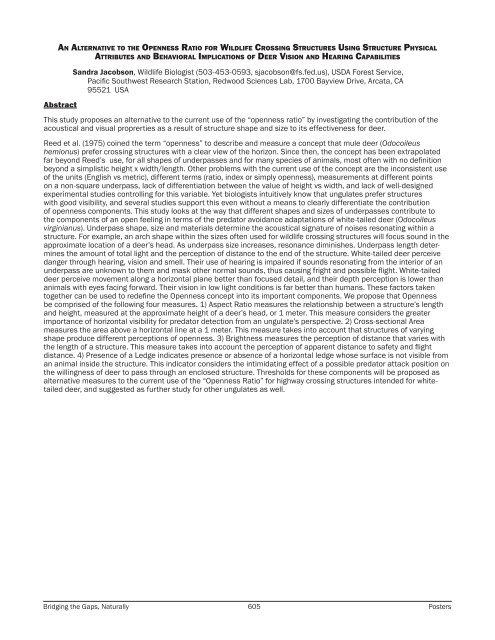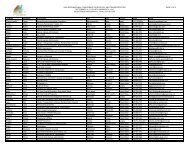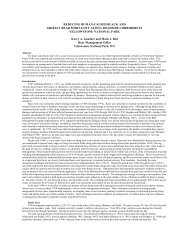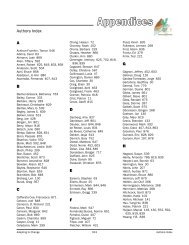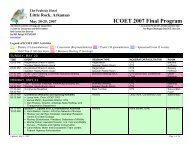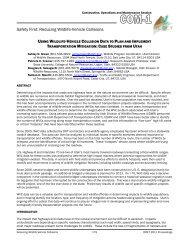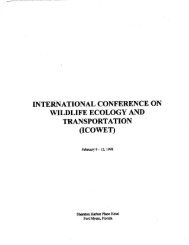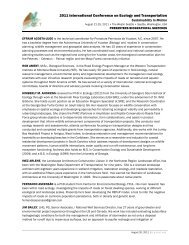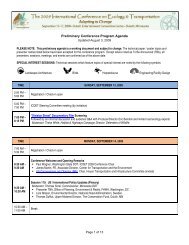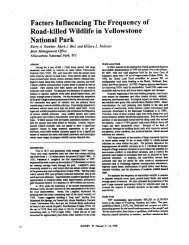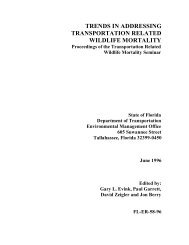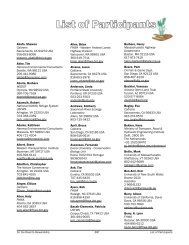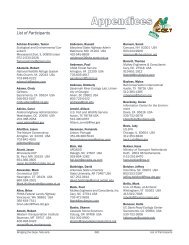Poster Sessions, pages 567-640 - ICOET
Poster Sessions, pages 567-640 - ICOET
Poster Sessions, pages 567-640 - ICOET
You also want an ePaper? Increase the reach of your titles
YUMPU automatically turns print PDFs into web optimized ePapers that Google loves.
An Alternative to the Openness Ratio for Wildlife Crossing Structures Using Structure Physical<br />
Attributes and Behavioral Implications of Deer Vision and Hearing Capabilities<br />
Abstract<br />
Sandra Jacobson, Wildlife Biologist (503-453-0593, sjacobson@fs.fed.us), USDA Forest Service,<br />
Pacific Southwest Research Station, Redwood Sciences Lab, 1700 Bayview Drive, Arcata, CA<br />
95521 USA<br />
This study proposes an alternative to the current use of the “openness ratio” by investigating the contribution of the<br />
acoustical and visual proprerties as a result of structure shape and size to its effectiveness for deer.<br />
Reed et al. (1975) coined the term “openness” to describe and measure a concept that mule deer (Odocoileus<br />
hemionus) prefer crossing structures with a clear view of the horizon. Since then, the concept has been extrapolated<br />
far beyond Reed’s use, for all shapes of underpasses and for many species of animals, most often with no definition<br />
beyond a simplistic height x width/length. Other problems with the current use of the concept are the inconsistent use<br />
of the units (English vs metric), different terms (ratio, index or simply openness), measurements at different points<br />
on a non-square underpass, lack of differentiation between the value of height vs width, and lack of well-designed<br />
experimental studies controlling for this variable. Yet biologists intuitively know that ungulates prefer structures<br />
with good visibility, and several studies support this even without a means to clearly differentiate the contribution<br />
of openness components. This study looks at the way that different shapes and sizes of underpasses contribute to<br />
the components of an open feeling in terms of the predator avoidance adaptations of white-tailed deer (Odocoileus<br />
virginianus). Underpass shape, size and materials determine the acoustical signature of noises resonating within a<br />
structure. For example, an arch shape within the sizes often used for wildlife crossing structures will focus sound in the<br />
approximate location of a deer’s head. As underpass size increases, resonance diminishes. Underpass length determines<br />
the amount of total light and the perception of distance to the end of the structure. White-tailed deer perceive<br />
danger through hearing, vision and smell. Their use of hearing is impaired if sounds resonating from the interior of an<br />
underpass are unknown to them and mask other normal sounds, thus causing fright and possible flight. White-tailed<br />
deer perceive movement along a horizontal plane better than focused detail, and their depth perception is lower than<br />
animals with eyes facing forward. Their vision in low light conditions is far better than humans. These factors taken<br />
together can be used to redefine the Openness concept into its important components. We propose that Openness<br />
be comprised of the following four measures. 1) Aspect Ratio measures the relationship between a structure’s length<br />
and height, measured at the approximate height of a deer’s head, or 1 meter. This measure considers the greater<br />
importance of horizontal visibility for predator detection from an ungulate’s perspective. 2) Cross-sectional Area<br />
measures the area above a horizontal line at a 1 meter. This measure takes into account that structures of varying<br />
shape produce different perceptions of openness. 3) Brightness measures the perception of distance that varies with<br />
the length of a structure. This measure takes into account the perception of apparent distance to safety and flight<br />
distance. 4) Presence of a Ledge indicates presence or absence of a horizontal ledge whose surface is not visible from<br />
an animal inside the structure. This indicator considers the intimidating effect of a possible predator attack position on<br />
the willingness of deer to pass through an enclosed structure. Thresholds for these components will be proposed as<br />
alternative measures to the current use of the “Openness Ratio” for highway crossing structures intended for whitetailed<br />
deer, and suggested as further study for other ungulates as well.<br />
Bridging the Gaps, Naturally 605 <strong>Poster</strong>s


